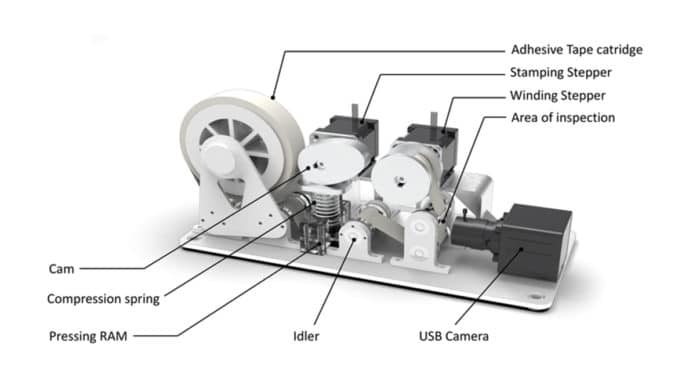Cleaning large public spaces such as hospitals, government buildings, shopping malls, or airports is time-consuming. Therefore, cleaning robots are being used to autonomously clean floors and other surfaces in such places. However, as COVID-19 highlights the need to keep public spaces clean, how can we be sure that the areas covered by cleaning robots are indeed clean?
Researchers from the Singapore University of Technology and Design (SUTD), supported by the National Robotics Programme, have designed a sensor that lets autonomous robots efficiently and systematically determine an area’s cleanliness. Currently, in development, the device includes a roll of white, adhesive tape, a stepper motor, a motorized spring-loaded plunger, and a USN camera for visually examining the tape.
The sensor works by the “touch-and-inspect” analogy, pressing a white, adhesive tape onto the floor and scans for dirt particles in the tape. By measuring the degree of dissimilarity between the photo of the tape before and after it was pressed, the team came up with a dirt score that can be assigned to the area. The sensor could also count the number of pixels corresponding to dirt on the photo of the tape, providing insight into the area’s dirt density.
“With this sensor that assigns a dirt score to an area using the touch-and-inspect analogy, what we need to do next is design the robot that could ‘touch’ a huge region,” said Mr. Thejus Pathmakumar, a Ph.D. student at SUTD.
To make exploration smarter, the researchers programmed an algorithm that would encourage the robot to explore regions more likely to be dirty. Their dirt-probability-driven algorithm prompted the robot to notice changes in the floor’s visual patterns that may indicate dirt, after which the robot would be directed to navigate into the center of the region.
Based on the data from the touch-and-inspect method, the robots quantified an area’s cleanliness with a cleaning benchmark score between 0 and 100, with scores closer to 100 correspondings to cleaner surfaces. The team tested their cleaning robots on a mix of indoor and semi-outdoor areas.
“In this work, we focused on the visual and tactile aspects that a robot would use to audit cleanliness,” explained SUTD Assistant Professor Mohan Rajesh Elara, principal investigator of the project and co-founder of robotics company Lionsbot. “In the future, we are looking to comprehensively audit the quality of cleaning, taking into account not just the visual and tactile aspects, but also the olfactory aspects and microbial density.”
